If you’ve been following the news recently you may have seen articles about legislation trying to pass laws allowing increased use of Dental  Therapists in under-served populations. There has been a lot of controversy about this subject because of exactly what a dental therapist is and their role in dental care in the United States.
Currently dental therapists are allowed to practice in Alaska and Minnesota. However, there has been discussion about other states such as Connecticut, Oregon, New Hampshire and California allowing dental therapists to practice. Dental therapists are defined by the University of Minnesota School of Dentistry as ” a licensed oral health professional who practices as part of the dental team to provide educational, clinical and therapeutic patient services. Dental therapists provide basic preventive and restorative treatment to children and adults, and extractions of primary (baby) teeth under the supervision of a dentist. Dental therapists work primarily in settings that serve low-income and under served patients, or in a dental health shortage area.”
Individuals participating in dental therapy programs have training that is significantly shorter than general dentists. A dental therapist must complete at least one year of undergraduate college course work before they can participate in a 2 1/2 year program to teach them the basic skills of local anesthesia, preventative dentistry (such as cleanings and dental sealants), uncomplicated extractions, radiology as well as diagnosis and treatment of cavities. As opposed to general dentists who, in most circumstances, must complete four years of undergraduate college, four years of dental school and in New York state a year of residency.
So what exactly is all the commotion about allowing dental therapists to practice in under served areas? There has been a question about how to address the growing need for care, especially with children, however due to therapists limited training the American Dental Association has brought up concerns that they are not equipped to provide the level of care necessary to complete many of the procedures they are being licensed to perform. And, since many are not reversible such as extractions and fillings, there should be better training of these professionals. Other organizations have made the argument that patients that have medicaid or are in areas with a poor dentist to patient ratio are unable to receive appropriate dental care due to cost of dentistry and many general dentists not accepting these patients into their practices. So the conundrum is how do we provide appropriate care for this needful population in a safe and ethical way. Are dental therapists the solution to this problem or the creation of an even bigger problem?]]>
Therapists in under-served populations. There has been a lot of controversy about this subject because of exactly what a dental therapist is and their role in dental care in the United States.
Currently dental therapists are allowed to practice in Alaska and Minnesota. However, there has been discussion about other states such as Connecticut, Oregon, New Hampshire and California allowing dental therapists to practice. Dental therapists are defined by the University of Minnesota School of Dentistry as ” a licensed oral health professional who practices as part of the dental team to provide educational, clinical and therapeutic patient services. Dental therapists provide basic preventive and restorative treatment to children and adults, and extractions of primary (baby) teeth under the supervision of a dentist. Dental therapists work primarily in settings that serve low-income and under served patients, or in a dental health shortage area.”
Individuals participating in dental therapy programs have training that is significantly shorter than general dentists. A dental therapist must complete at least one year of undergraduate college course work before they can participate in a 2 1/2 year program to teach them the basic skills of local anesthesia, preventative dentistry (such as cleanings and dental sealants), uncomplicated extractions, radiology as well as diagnosis and treatment of cavities. As opposed to general dentists who, in most circumstances, must complete four years of undergraduate college, four years of dental school and in New York state a year of residency.
So what exactly is all the commotion about allowing dental therapists to practice in under served areas? There has been a question about how to address the growing need for care, especially with children, however due to therapists limited training the American Dental Association has brought up concerns that they are not equipped to provide the level of care necessary to complete many of the procedures they are being licensed to perform. And, since many are not reversible such as extractions and fillings, there should be better training of these professionals. Other organizations have made the argument that patients that have medicaid or are in areas with a poor dentist to patient ratio are unable to receive appropriate dental care due to cost of dentistry and many general dentists not accepting these patients into their practices. So the conundrum is how do we provide appropriate care for this needful population in a safe and ethical way. Are dental therapists the solution to this problem or the creation of an even bigger problem?]]>
Posts
With studies coming out everyday linking how important a healthy lifestyle is its no surprise to see  changes in the diet choices of the general population. Besides overall health nutrition and dental health is also an important subject that many are not aware of. Vegetarians; whether lacto-vegetarians, ova-vegetarians, semi-vegetarians or vegans; as well as people dieting or radically changing their diet, should be more aware of the food they are eating to be sure they are including foods rich in the vitamins and minerals needed to keep your body healthy and your smile beautiful.
Being a dentist we find that we see nutritional deficiencies apparent in the tissues of the mouth before you may notice them elsewhere. Some of the more important nutrients that may be neglected when changing your diet that are important for your oral and general health are:
changes in the diet choices of the general population. Besides overall health nutrition and dental health is also an important subject that many are not aware of. Vegetarians; whether lacto-vegetarians, ova-vegetarians, semi-vegetarians or vegans; as well as people dieting or radically changing their diet, should be more aware of the food they are eating to be sure they are including foods rich in the vitamins and minerals needed to keep your body healthy and your smile beautiful.
Being a dentist we find that we see nutritional deficiencies apparent in the tissues of the mouth before you may notice them elsewhere. Some of the more important nutrients that may be neglected when changing your diet that are important for your oral and general health are:
- Calcium: This nutrient is very important for bone health, as well as helping to maintain healthy gums and reduce your risk for cavities. Calcium is typically found in leafy green vegetables, dairy products, as well as in legumes and some shellfish.
- Vitamin B12 and Vitamin B2: A deficiency in these two vitamins can cause mouth sores. Vitamin B2 can be found in milk and cheese, leafy green vegetables, beans, bananas, and almonds. Vitamin B12 can be found in some shellfish, cheese, and eggs.
- Niacin or Vitamin B3: A deficiency in this vitamin can cause bad breath and sores in the mouth. Niacin can be found in eggs, tuna, salmon and halibut, avocados, dates, leaf vegetables and various nuts and legumes
- Vitamin D: this nutrient helps with the absorption of calcium, when lacking vitamin D some may suffer from something called burning mouth syndrome which can cause and uncomfortable sensation of the tongue and mouth.
- Iron: a decrease in Iron can present itself as a sore inflamed tongue and may cause sores inside your mouth to form as well. Iron-rich foods are eggs, lentils and other dried beans, shrimp, cod and tuna, spinach, sweet potatoes, broccoli and peas. Accordingly foods that boost iron absorption the most are meat, a good iron supplement and foods high in vitamin C.
- Vitamin C: this vitamin is important for healing as well as general health a deficiency can present itself as bleeding gums and loose teeth. You can find vitamin C in Citrus fruits, sweet potatoes and red peppers.
- Some other important vitamins for oral health are Vitamins A, E and K.
Chronic teeth grinding or Bruxism
is a condition that many people suffer from but are mostly unaware of.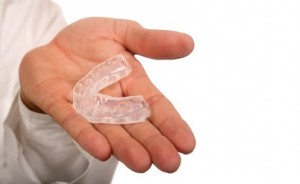 Bruxism can occur during the day or night but for most people occurs at night. This habit can cause significant damage to the teeth and cause discomfort to the structures that hold your jaw and TMJ in place. Although many speculate what causes people to clench and grind often times there is no clear cause for it and may resolve on its own.
Bruxism can occur during the day or night but for most people occurs at night. This habit can cause significant damage to the teeth and cause discomfort to the structures that hold your jaw and TMJ in place. Although many speculate what causes people to clench and grind often times there is no clear cause for it and may resolve on its own.
Common signs that you may be grinding your teeth are:
- Flattening of biting surfaces of teeth
- Pain in jaw muscles and temples
- Pain when biting in molar area
- Scalloping or indentation of the sides of tongue
- Scooping out of flat part of teeth along gum line
- Popping and clicking of the jaw
cavity free mouth and, all the great tools available to help you do so. 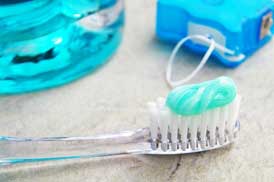 Next comes the last part, maintenance of your repertoire of home care tools. So if you’ve ever wondered ‘How to keep my toothbrush clean?’ then read on..
Next comes the last part, maintenance of your repertoire of home care tools. So if you’ve ever wondered ‘How to keep my toothbrush clean?’ then read on..
Your toothbrush is the most important tool in your home care regimen so keeping it clean and up to date is very important. Here are the basics:
1. Whether using an electric toothbrush or a manual toothbrush it should be replaced every 3 months. The easiest way is to change your brush or electric toothbrush head with the change of the seasons or if the bristles begin to look splayed or frayed. 2. While brushing your teeth your brush is cleaning all the debris, plaque and bacteria that you’ve accumulated over the day. After brushing you should sanitize your toothbrush, we recommend rinsing it with Listerine then rinsing with water and letting air dry. 3. And lastly, When storing your toothbrush you want to store it head up allowing it to air dry in an area away from an open toilet. If you can store it in a medicine cabinet or something similar that is best.Many of our patients own and use appliances at home whether they be retainers, Invisalign aligners, nightguards or sleep apnea oral appliances, these appliances need special care to maintain them and keep them clean.
1. In the morning upon removal of the appliance you should use a wet toothbrush to gently clean off the appliance, stay away from abrasive toothpastes when cleaning any appliance made of acrylic or soft rubbery material as the toothpaste may cause it to become porous and more susceptible to bacteria buildup. 2. Many of your appliances can be soaked in a chlorhexidine mouth rinse or Listerine for a period of time to help reduce bacteria build up as well. Please check with your dentist before you do so as some of these rinses may stain certain materials 3. Also, for clear retainers and Invisalign aligners, often over time the aligners may discolor due to normal wear. You can place your retainer or aligner in a small glass of water with a cap full of hydrogen peroxide, this will help clear up the stain on the aligner.]]>  The studies were spurred on by the increase in consumption of sports and energy drinks, especially by adolescents. The study warned that both sports drinks and energy drinks have pH levels that are at a level of acidity that can cause demineralization or weakening of the enamel. Also, they found that they both contain citric acid, included to help improve the taste and shelf life of the drink, which can also have an effect on enamel. The study showed, that although both sports and energy drinks are acidic enough that if excessively consumed they can cause damage to dental enamel, energy drinks have a “significantly greater potential for enamel dissolution than sports drinks”.
The study also brought to light some interesting information:
The studies were spurred on by the increase in consumption of sports and energy drinks, especially by adolescents. The study warned that both sports drinks and energy drinks have pH levels that are at a level of acidity that can cause demineralization or weakening of the enamel. Also, they found that they both contain citric acid, included to help improve the taste and shelf life of the drink, which can also have an effect on enamel. The study showed, that although both sports and energy drinks are acidic enough that if excessively consumed they can cause damage to dental enamel, energy drinks have a “significantly greater potential for enamel dissolution than sports drinks”.
The study also brought to light some interesting information:
- ” Approximately 30-50% of adolescents and young adults in the U.S. consume energy drinks and that 51-62% of adolescents consume at least one sports drink per day”
- Energy drinks are a fairly new and quickly growing product and there haven’t been many studies on the effects of energy drinks. One statistic showed that energy drinks are such a growing market that “200 new brands of energy drinks were launched in 2007 alone”. Also, because of new flavors and formulations are being created so frequently and the vast differences even between effects of flavors of the same brand, it is very difficult to generalize about these effects.
- Different flavors within the same brand had different levels of acidity.
- Of all the drinks tested “Gatorade Blue was found the highest titratable acidity” Also, Red Bull Sugar Free, Monster Assault, 5-Hour Energy, Von Dutch, and Rock Star had higher acidity than Red Bull, Rip It, Full Throttle Fury and MDX.
A comparison of sports and energy drinks—Physiochemical properties and enamel dissolution; By Poonam Jain, BDS, MS, MPH; Emily Hall-May, MS; Kristi Golabek; Ma Zenia Agustin, PhD
]]> Over the last few years there has been an increase or reported cases of MRSA infections. Many of my patients ask me about the risk of oral MRSA infections and how it can effect them. Our mouths are home to over 300 different types of bacteria. 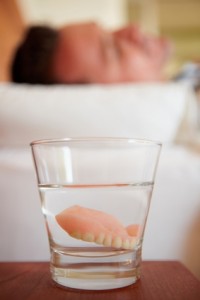 In a healthy mouth, these bacteria work together to create a healthy oral environment. But, as in any other system, if things go awry and the balance becomes upset then we find different types of bacteria take advantage of this and begin to thrive.
In a healthy mouth, these bacteria work together to create a healthy oral environment. But, as in any other system, if things go awry and the balance becomes upset then we find different types of bacteria take advantage of this and begin to thrive.
So does the average person have MRSA in their mouth?
Studies have shown that the population that has the highest incidence of MRSA colonization are elderly patients in nursing homes as well as patients with advanced malignant diseases suffering from reduced salivary flow rate.What can they do to reduce the amount of bad bacteria in our mouths?
MRSA tends to like to grow on the porous surfaces of dentures as well as being found in plaque in the mouth. Some studies have shown that a good way to clean MRSA infected dentures is with a chlorhexidine oral rinse as well as soaking the dentures in chlorhexidine for 10 minutes once a week. Dentures should be cleaned daily with a stiff brush and soap and water, not toothpaste. And even, if you wear dentures you should be cleaning your gums and remaining teeth as well. Some studies also suggest microwaving your dentures for 3 minutes. However, I don’t suggest this if you have any portion of your denture that is metal.What kind of risks are there if you have MRSA in your mouth?
There are no studies that offer clear associations of MRSA colonization in the mouth causing systemic and dental problems. Although, the bacteria having been found in some orofacial abscesses as well as some infections located on the gingiva and corners of the mouth commonly associated with denture wear. So although there have been few instances of this type of bacteria found in oral infections the concern is for the potential for these strains to re-colonize at other body sites or become a source of cross-infection to other patients or hospital/nursing home staff.The ecology of Staphylococcus species in the oral cavity; A. J. Smith, M. S. Jackson and J. Bagg Staphylococcus aureus in the oral cavity: a three-year retrospective analysis of clinical laboratory data; A.J. Smith, D. Robertson, M. K. Tang, M. S. Jackson, D. MacKenzie & J. Bagg MRSA infection; K. Valand & P.M. McLoughlin
]]> 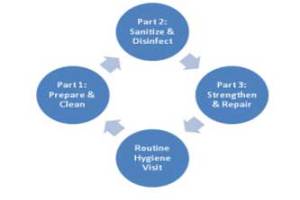 After years in the dental office, I can tell you that it’s very rare to find a patient who goes more than 3 years without a cavity.
Knowing that home care is one of the most important aspects of maintaining a healthy mouth, my partners and I set out on creating a home care regimen that’s relatively easy and will provide the results we are hoping to achieve, a decrease in cavities and improvement in overall oral health.
The final breakthrough of my home care routine recommendations came while reading Dr. Ellie Phillips book Kiss Your Dentist Goodbye. During our daily care routine, we are mainly focusing on removing and repairing the damage we’ve already done during the day. Removing plaque mostly and strengthening enamel. However, Dr. Ellie’s book brings up a great point, we aren’t focusing on improving the overall environment of the mouth, more specifically saliva makeup.
Combining both rationales, ours which focuses on mechanics and repair, and Dr. Ellie’s which focuses on reducing the saliva’s acidity and creating a healthier environment in the mouth, we created Frangella Dental’s basic home care regimen:
After years in the dental office, I can tell you that it’s very rare to find a patient who goes more than 3 years without a cavity.
Knowing that home care is one of the most important aspects of maintaining a healthy mouth, my partners and I set out on creating a home care regimen that’s relatively easy and will provide the results we are hoping to achieve, a decrease in cavities and improvement in overall oral health.
The final breakthrough of my home care routine recommendations came while reading Dr. Ellie Phillips book Kiss Your Dentist Goodbye. During our daily care routine, we are mainly focusing on removing and repairing the damage we’ve already done during the day. Removing plaque mostly and strengthening enamel. However, Dr. Ellie’s book brings up a great point, we aren’t focusing on improving the overall environment of the mouth, more specifically saliva makeup.
Combining both rationales, ours which focuses on mechanics and repair, and Dr. Ellie’s which focuses on reducing the saliva’s acidity and creating a healthier environment in the mouth, we created Frangella Dental’s basic home care regimen:
Part 1: Prepare & Clean
This portion of your home care focuses on the mechanical aspect of cleaning your mouth. The first step is to prepare the right oral environment. You can do this by using an oral rinse that creates a less acidic pH in your mouth. The product we recommend is CloSYS. We also recommend investing in a good electric tooth brush. Our favorite is the Sonicare tooth brush. Find floss that works best for you. I generally recommend unwaxed tape varieties of floss as opposed to the rope type. The brand I recommend the most is Glide.Part 2: Sanitize & Disinfect
Directly after brushing and flossing your teeth, the next step is to rinse with an antibacterial rinse. Our favorite product on the market is Listerine. After brushing your teeth, be sure to sanitize your tooth brush, you can do this by rinsing your brush in Listerine, then rinsing with water and allowing to air dry. Also, always store your toothbrush away from open toilets as well.Part 3: Strengthen & Repair
This portion of home care helps keep your enamel strong and healthy. At night, as the last step of your home care, you should rinse with a fluoride rinse. We recommend ACT Total Care fluoride rinse. After you have rinsed with the fluoride rinse, do not rinse with water. Also, throughout the day, to give added protection, you can chew xylitol gum or use other 100% xylitol products. You want to aim for about 6-10 grams a day of xylitol to get the best anticavity effects of this sugar substitute. To see all of Frangella Dental’s recommeded home care products, click here.]]>  Being a dentist and being surrounded by a lot of dentists, I’ve had the opportunity to try a lot of dental products over the years and learn the opinions of my friends, family and colleagues about these same products.
I decided to compile a list of my absolute favorite, tried and true, dental products on the market. Of course I’m always open to try something new, so if you have any favorites, please let us know!
Being a dentist and being surrounded by a lot of dentists, I’ve had the opportunity to try a lot of dental products over the years and learn the opinions of my friends, family and colleagues about these same products.
I decided to compile a list of my absolute favorite, tried and true, dental products on the market. Of course I’m always open to try something new, so if you have any favorites, please let us know!
Toothbrush: Sonicare
This toothbrush’s sonic motion and handy timer really make a difference in your smile. It’s the best home care tool in my opinion.Floss: Glide
Whenever I buy floss, I tend to lean towards an unwaxed tape variety rather than a rope. Glide is great b/c its easy to manuever between teeth and doesn’t shred easily.Regular Toothpaste: Crest Original (with sodium fluoride)
Crest is a great product. I like the flavor of the paste and usually prefer sodium fluoride in my toothpaste as opposed to stannous fluoride. When I’m looking to buy a regular toothpaste I usually stick to the Crest Original.Toothpaste for Sensitive Teeth: Sensodyne Isoactive
For patients that are long time users of toothpaste for sensitive teeth, this new product is a great change from the dull chalky tasting toothpastes that have been on the market. I tried this product about 6 months ago and use it from time to time when my teeth become hot & cold sensitive. It forms a refreshing foam that leaves you with a great taste and more comfortable teeth as well.Whitening Toothpaste: Crest 3d White
When brushing your teeth in between whitenings to keep that beautiful fresh smile I like to use this Crest 3d White. It’s Crest, which has a great line of whitening products, and also has a great taste and is very effective in maintaining a bright smile.Antibacterial Mouthwash: Listerine and Closys
An antibacterial mouthwash is crucial to home care. The hard part is sorting through all the options and finding whats right for you. My top two picks are: CloSys and Listerine. I love CloSys because although it has a mild flavor, it is a great tool to kill bacteria that can lead to periodontal disease and also it is less acidic than many of the rinses on the market. My other top pick is Listerine. In my opinion Listerine is hands down the most effective antibacterial rinse on the market. My morning routine usually includes a quick rinse with CloSys then a thorough brushing & flossing followed by a rinse with Listerine.Fluoride Mouthwash: ACT Total Care
I always rinse with ACT right before bed. It has a great flavor (my favorite is the green one), probably the best tasting of all the mouthrinses I’ve tried, and is very effective in helping remineralize and strengthen enamel. Another great product worth trying.100% Xylitol Gum: Epic (epicdental.com)
Xylitol is a great sugarfree product that is important to home care. I usually opt for 100% Zylitol chewing gum (right now I’m addicted to Epic cinnamon flavor). The only downfall is the chewing gum doesn’t keep its flavor for that long. But on the upside, even after only chewing it for a short amount of time, my mouth feels really fresh and clean afterwards. And it’s a great way of delivering Xylitol, which is the only sugar substitute that studies have shown that has cavity fighting properties.]]> 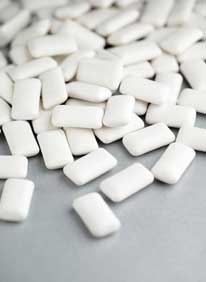 100% Xylitol can be consumed in many different product forms: mints, gum, lollipops, and granular just to name a few. Many commercial sugarless gums, which are not 100% Xylitol, contain approximately .5 grams of Xylitol per piece. It is recommended that 6-10 grams of Xylitol be consumed daily by children and adults. Therefore, it is recommended that a product with 100% Xylitol be consumed instead.
Products with 100% Xylitol can be difficult to find at your everyday local grocery store but you can usually find 100% Xylitol at health/organic food stores and on the Internet.
Xylitol is also recommended for infants and can be started with a few grams a day once the teeth begin erupting, working up to 6-10 grams as all the teeth have fully erupted. Since babies cannot chew gum/lollipop/mints, we recommend Xylitol be introduced in a granular form mixed in water. A wash cloth bathed in this solution can be used to clean the newly erupted teeth. Speak with your dentist or a pediatric dentist before introducing Xylitol.]]>
100% Xylitol can be consumed in many different product forms: mints, gum, lollipops, and granular just to name a few. Many commercial sugarless gums, which are not 100% Xylitol, contain approximately .5 grams of Xylitol per piece. It is recommended that 6-10 grams of Xylitol be consumed daily by children and adults. Therefore, it is recommended that a product with 100% Xylitol be consumed instead.
Products with 100% Xylitol can be difficult to find at your everyday local grocery store but you can usually find 100% Xylitol at health/organic food stores and on the Internet.
Xylitol is also recommended for infants and can be started with a few grams a day once the teeth begin erupting, working up to 6-10 grams as all the teeth have fully erupted. Since babies cannot chew gum/lollipop/mints, we recommend Xylitol be introduced in a granular form mixed in water. A wash cloth bathed in this solution can be used to clean the newly erupted teeth. Speak with your dentist or a pediatric dentist before introducing Xylitol.]]>
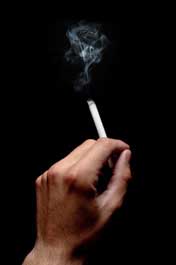 Smoking is not only bad for your heart and lungs but your mouth too.
Here are the alarming statistics:
Smoking is not only bad for your heart and lungs but your mouth too.
Here are the alarming statistics:
- Smokers are three times more likely than non-smokers to lose all their teeth. This figure has not changed from a decade ago.
- Smoking can result in periodontal gum disease, bad breath, staining of the tongue and teeth, delayed healing and complications with certain dental procedures, plaque build-up, and a diminished sense of taste and smell.
- About 28,000 people are diagnosed with oral cancer a year and 7,200 die from oral cancer each year.
- It has been reported by the Academy of General Dentistry that a one-pack-a-day smoking habit can cost you the loss of at least two teeth every 10 years. Smoking can also lead to seven times the risk of developing gum disease compared to non-smokers.
- About eight out in ten people with mouth and throat cancers are tobacco users. On average, 40 percent of those with the disease will not survive more than five years after being diagnosed, as quoted by the American Dental Association.
- According to the American Cancer Society, it is estimated that about 8 out of 10 oral cancers could be prevented by avoiding both tobacco and alcohol use. Many of the chemicals found in tobacco can damage DNA directly. Scientists are not sure whether alcohol directly damages DNA but they have shown that alcohol helps many DNA-damaging chemicals get into cells more easily. This may be why the combination of tobacco and alcohol damages DNA far more than tobacco alone.
Frangella Dental
Offering advanced techniques in Cosmetic and General Dentistry in New York City.
200 W. 57th Street, Suite 1405
New York, NY 10019
(212) 245-2888
care@drfrangella.com
